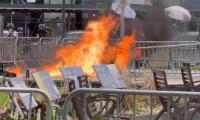Last week, an anti-terrorism court handed down death to the prime suspect in the Zainab murder case, Imran Ali, on four counts, one life term, a 7-year jail term, and also imposed on him fines of around Rs4 million.
The news of the serial killer being handed down capital punishment may have brought some comfort to Zainab’s bereaved family. But what of the thousands of children who are kidnapped, sexually molested and tortured – most of them murdered – almost on a daily basis? A report by the Ministry of Human Rights reads that a whooping 17,862 cases of child abuse have been reported in the country since 2013. The report further states that in 10,620 of these cases, the victims are girls, whereas 7,242 are boys. But only in 112 cases were the accused convicted. Among these, death sentences were handed down in only 25 cases, while 11 convicts were awarded life imprisonments.
According to a survey conducted by non-governmental organisation Sahil, 11 children are sexually abused in Pakistan every day. However, it is widely believed that the number is actually higher as many cases go unreported. But this is only part of the story. The ill-fated kids who are born in Pakistan start facing hardships right after their birth. According to the latest report released by Unicef, Pakistan is the riskiest place for newborns as measured by its infant mortality rate. The report notes that for every 1,000 babies born in Pakistan in 2016, 46 died before the end of their first month – a staggering 1 in 22.
Every year 2.6 million babies die before turning a month old. One million of them take their first and last breath on the day they are born. Another 2.6 million are still-born. More than 80 percent of the deaths occur as a result of premature birth, complications during labour and delivery or infections such as sepsis, meningitis and pneumonia.
The risk of a newborn dying varies enormously, depending on which country a baby is born in. Experts believe that newborn survival is closely linked to a country’s income level. A baby born in Pakistan is 50 times more likely to die during the first month than a baby born in Japan, Iceland and Singapore – said to be the safest countries to be born in.
Medical experts believe that lack of safe drinking water, proper disposal of excreta (wastes), low immunisation and malnutrition are the main causes for the rising infant mortality rate.
Let’s take a look at our national health. The deteriorating situation of our national health can be gauged from the fact that only 0.7 percent of the total GDP is allocated to maintain the health of over 200 million Pakistanis, against the World Health Organisation’s (WHO) standard of between 4-5 percent of the GDP.
According to the Pakistan Demographic Survey, only 38 percent of the people are fully immunised. As per a study conducted by the National Nutrition Survey (NNS 2011), 40 percent of the children are malnourished, whereas 49 percent of the country’s women are iron deficient. This malnourishment, coupled with low immunisation and ignorance proves more harmful for those who are poor.
Forty percent of the people in Pakistan live below the poverty line, with their incomes being less than two dollars a day. According to a survey conducted by the Aga Khan Foundation, a consultation at a proper medical practitioner would cost Rs875. This leaves the poor with little option but to go to quacks and spiritual healers. Those who manage to overcome these barriers have to face another challenge after they grow up. Instead of going to school, these children are forced into labour. In efforts to feed their families, they can be seen begging on the streets or swelling the ranks of terrorist organisations, if not engaged in bonded labour.
The statistics concerning out-of-school children paint a further gloomy picture. The Pakistan Education Statistic 2015-2016, revealed that the number of out-of school-children had reached up to 22.6 million; calling for imposition of a real education emergency. As many as 44 percent children between the ages of five and 16 are still out of school.
The statistics further reveal that 21 percent of the primary schools are being run by a single teacher, while 14 percent have one room. Surprisingly, only 30 percent of the children are enrolled in classes 1 till 10th. Forty percent of the public-sector primary schools are operating without electricity, 28 percent do not have toilets, 25 percent are without boundary walls and 29 percent have no access to drinking water. Moreover, 7 percent of the schools do not have any building and 43 percent have unsatisfactory buildings. The situation is even worse in Balochistan and Fata.
One cannot deny the significance of metro buses, road networks and infrastructure development, but we need to prioritise our issues for balanced development. We need to invest more on human capital. To that end, improving the adult literacy rate, initiating accelerated learning programmes for adult out-of-school children and encouraging non-formal education are some of the areas that need priority intervention to improve accessibility to education.
The writer is a freelance contributor.
Email: khan45@gmail.com
A woman walks past a building of the International Monetary Fund. — AFP/FileThe annual and spring meetings of the...
Late Benazir Bhutto's daughter Asifa Bhutto Zardari addresses the Christian community in Bihar Colony on January 23,...
Representational image. — PexelsWater is an important scarce natural resource that is required for several everyday...
Pakistani employees of online marketplace company Kaymu at work in Karachi. — AFP/FileThe true spirit of development...
India uses Afghanistan as a backstage area to carry out terrorist attacks against Pakistan
Another report by the Pakistan Institute of Peace Studies states that 78 per cent of attacks have been carried out by...







